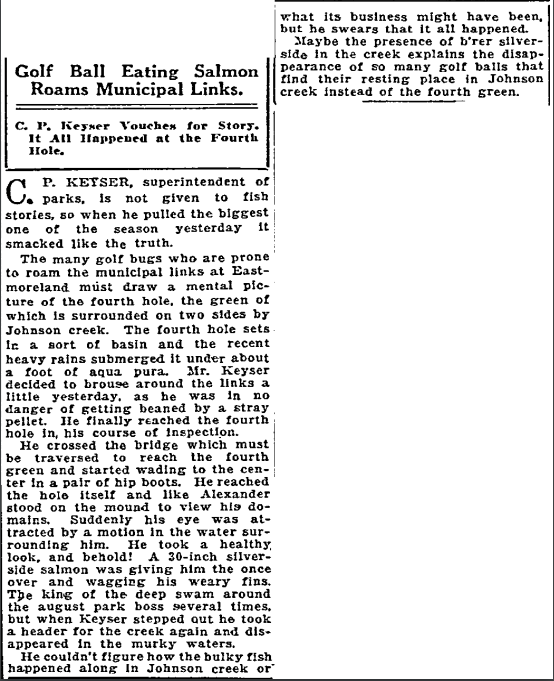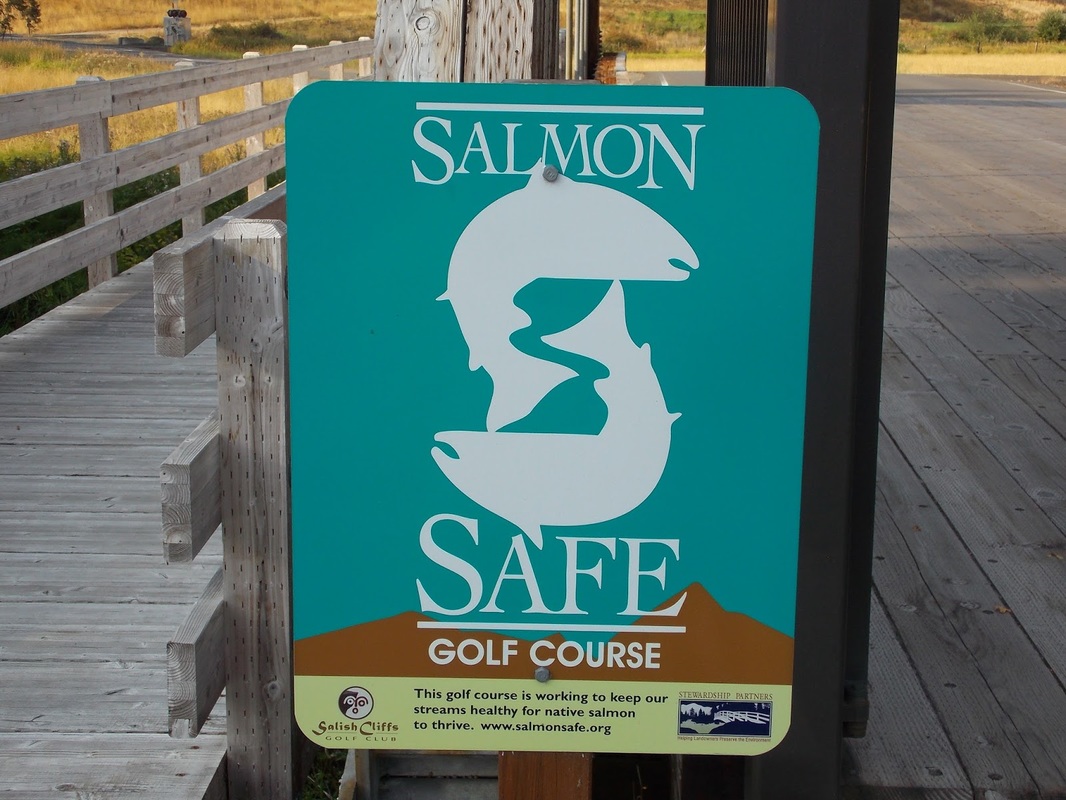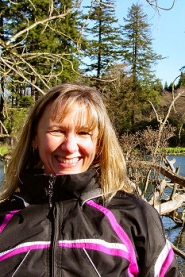|
You read that right - "Golf Ball Eating Salmon" is the headline for the Oregonian on November 22, 1921. Let's examine the article for the science, the history of this "fish tale" and trace the story to modern day.
C.P. Keyser vouches for the story. It all happened on the fourth hole.The many golf bugs who are prone to roam the municipal links at Eastmoreland must draw a mental picture of the fourth hole, the green of which is surrounded by two sides by Johnson Creek
Nowadays - only the old timers can paint this mental picture, because even though I've roamed these hallowed links for over a decade - I never played when Johnson Creek carved across and in front of the fourth hole green. Many of the men's club members cite this as a key feature of the topography that has since changed, as Johnson Creek was rerouted at least 25-50 years ago. In future articles we will explore how this change came about and the impact. on the course and creek.
For now, let's enjoy the fish tale: The fourth hole sets in a sort of basin and the recent heavy rains submerged it under a foot of water.
A foot of water!! Um .... that's the heavy stuff and will definitely slow play down. Thought Eastmoreland was soggy mess now? Well, this story dates well before the first major irrigation project in the early 193-'s which was required by the USGA in advance of the City hosting the 1933 National Publics Links Amatuer. Playing Eastmoreland then must have been a marshy rain flooding mess in the fall and spring in the very way nature intended. It also points to the reason Ladds would have offered this parcel for municipal golf - as developing houses along these banks would result in flooded basements.
He crossed the bridge which must be traversed to reach the fourth green and started wading to the center in a pair of hip boots
Two key items for us amatuer historians
First: the bridge... let me make a little prayer that in this historical project we can discover a photo this original bridge from 1920's - as well as any other bridge that might have been built later. Second: Keyser shows his dedication and we salute you! He waded out to the fourth green in hip boots no doubt to surmise the potential damage and also review the water table during the annual November rains. Keyser is a true steward of the land. He reached the hole itself and like Alexander stood on the mound to view his domains.
So this author just dropped an Alexander the Great reference (pow!) - and a truly fitting reference at that, since municipal golf owes its entire existence to this tenacious man - so does neighborhood Public Pools, the Zoo, Forest Park, the Rose Test Garden - and basically all that we value in Portland as the most livable city in America. But unlike Alexander, the water streaming down his cheeks were not tears wept because there were no more lands to conquer... just drops of rain on the face of a working man who saw that only through co-operation of the natural land and the people would the city grow to great potential.
Suddenly his eyes was attracted to a motion in the water surrounding him. He took a healthy look ,and behold! A 30-inch silver side salmon was giving him the once over and wagging his weary fins. The king of the deep swam around the august park boss several times...
.A Silver Side Salmon is now known as the Coho Salmon and it's cool to see this cited in the Oregonian because I have a link to a 2014 article in the Oregonian about Volunteers searching for Coho. Turns out that the clothing mill - potentially the forebear of the Oregon Worsted Company an employer of famed Eastmoreland golfer Frank - dammed Johnson Creek as early as the 1850's and severely impeded the Salmon spawning.
Which of course, we all know that spawning and the circle of life was the business of this salmon. In fact here's a video by a local biologist taking video of Coho Salmon spawning in Johnson Creek in October and you can clearly see the salmon wagging "his" weary fins. Though it's just as likely this was a female salmon protecting her eggs and counting the hours to her eventual death and decomposition to attract the bugs for her future fry to dine on. Enjoy a little science lesson on Coho Salmon spawning in Crystal Springs from Environmental Services fish biologist Melissa Brown.
What's curious to me is whether Keyser truly did not know "the business" of the fish's return to Johnson creek. Could it be true that Keyser may not have been aware of the spawning of Salmon in 1921? It seems unlikley to us in modern day.... though we must place oursleves there and understand that all Oregonians were just 60 years from coming from parts unfamiliar with the Pacific bounty of Salmon and the ecosystem that supports life. Its precisely this lack of knowledge that lead to decisions like dams, grates and other blockers that lead to great decline in salmon stocks.
The return of the Wild Coho, listed as a threatened species by the EPA in 1998, to Johnson Creek and the feeder tributary Crystal Springs is a result of restoration efforts funded by the federal, state and city government. As will cover in more detail Eastmoreland is now considered "Salmon-Safe" golf course through the efforts of these agencies in co-oporation with PP&R and Eastmoreland Superintendent Kathy Hauff who's helped achieve the designation of Eastrmoeland as "Salmon-Safe". See: Eastmoreland Golf Course plays role in fish habitat restoration plans |
|



 RSS Feed
RSS Feed